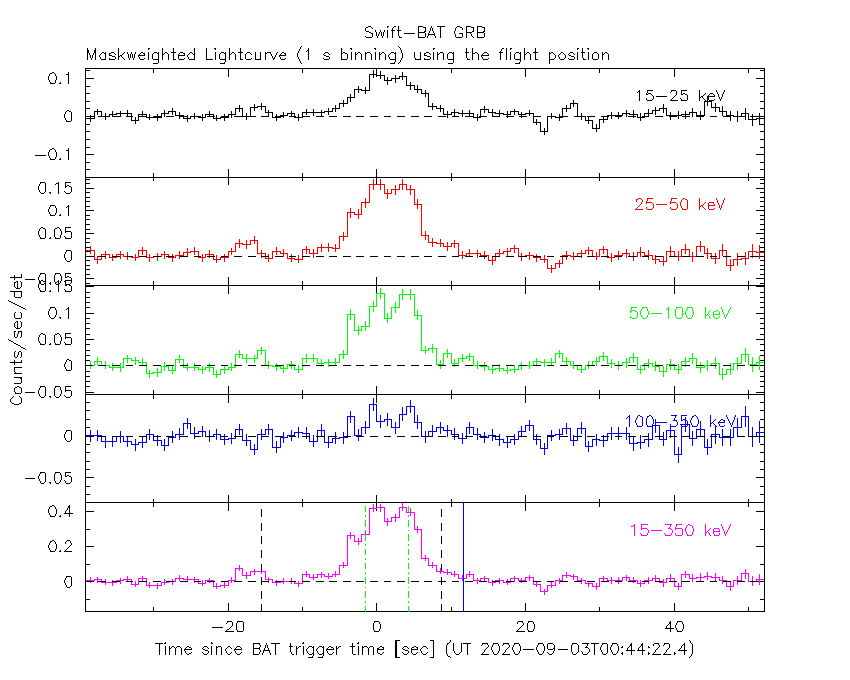
A.P. Beardmore (U. Leicester) for the Swift team
At 00:44:22 UT, the Swift Burst Alert Telescope (BAT) triggered and located GRB 200903A (trigger=994389) (Beardmore et al. GCN Circ. 28350). Swift did not slew immediately due to an observing constraint. At the time of the trigger, the initial BAT position was 43° from the Sun (0.1 hours East) and 138° from the 99%-illuminated Moon. Table 1 contains the best reported positions from Swift.
Table 2 is a summary of GCN Circulars about this GRB from observatories other than Swift.
Standard analysis products for this burst are available at https://gcn.gsfc.nasa.gov/swift_gnd_ana.html.
As reported by Ukwatta et al. (GCN Circ. 28360),
the BAT ground-calculated position is RA, Dec = 164.313, 50.488 deg which is RA(J2000) = 1
The mask-weighted light curve (Figure 1) shows a precursor at ~T-19 s, followed by the main structure with several overlapping pulses that starts at ~T-5 s and ends at ~T+20 s.
The burst went out of the BAT FOV at T+64 s.
The time-averaged spectrum from T-19.18 to T+22.13 s is best fit by a power law with an exponential cutoff.
This fit gives a photon index 1.15 ± 0.28, and
The results of the batgrbproduct analysis are available at https://gcn.gsfc.nasa.gov/notices_s/994389/BA/.
XRT refined results are not available.
UVOT results are not available.

Figure 1. The BAT
mask-weighted light curve in the four individual and total
energy bands. The units are counts
| RA (J2000) | Dec (J2000) | Error | Note | Reference |
|---|---|---|---|---|
| 1 |
+50°29'15.7" | 1.0' | BAT-refined | Ukwatta et al. GCN Circ. 28360 |
| Band | Authors | GCN Circ. | Subject | Observatory | Notes |
|---|---|---|---|---|---|
| Optical | Lipunov et al. | 28351 | Swift GRB200903.03: Global MASTER-Net observations report |
MASTER | |
| Gamma-ray | Fermi | 28349 | Fermi GBM Final Real-time Localization | Fermi GBM | |
| Gamma-ray | Shimizu et al. | 28357 | CALET Gamma-Ray Burst Monitor detection | CALET | |
| Gamma-ray | Lesage and Meegan | 28362 | Fermi GBM detection | Fermi GBM | Fluence=4.6±0.2x1 (5 |
September 5, 2020